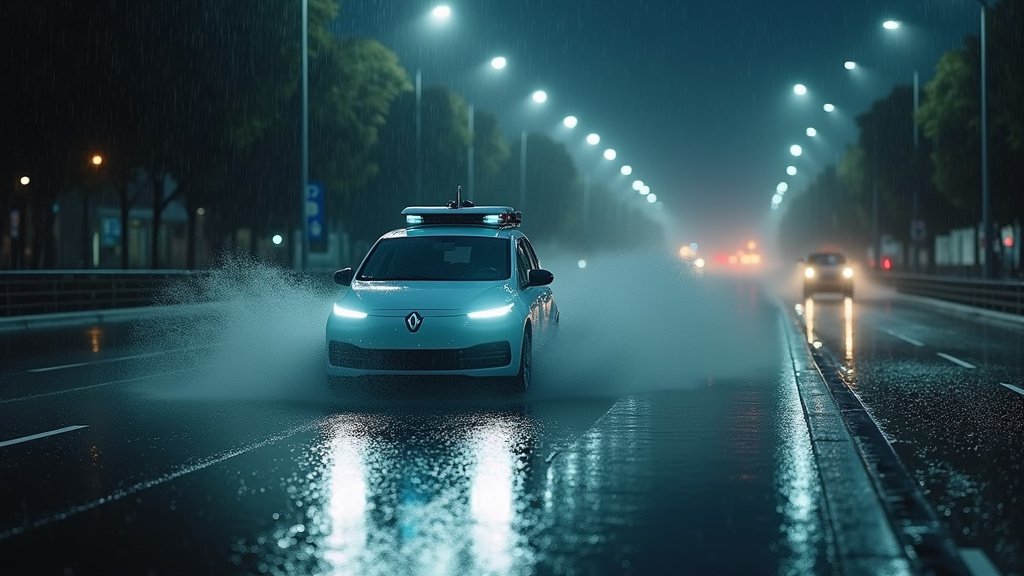In a significant development for autonomous vehicle technology, **Waymo Robotaxis Los Angeles** have officially begun operating on Los Angeles freeways, marking a new era for the company and for transportation in the region. This expansion coincides with a severe weather alert, as Southern California braces for torrential rain, with forecasters warning of potential flooding and mudslides.
Waymo Robotaxis Los Angeles: Now on Freeways
Alphabet’s autonomous driving subsidiary, Waymo, announced on November 12, 2025, that its fully driverless vehicles are now providing rides on freeways across Los Angeles, in addition to expansions in the San Francisco Bay Area and Phoenix. This move makes Waymo the first company in the United States to offer driverless rides on public highways, showcasing the capabilities of **Waymo autonomous driving**.
Previously confined to city streets and arterial roads, Waymo has been testing its vehicles on Los Angeles freeways with safety drivers since early 2025. The company stated that its artificial intelligence is equipped to handle the unique demands of highway driving, supported by robust **Waymo safety protocols**. The expansion of **Waymo Robotaxis Los Angeles** is seen as a natural evolution, enabling Waymo to offer longer-distance trips and potentially compete more directly with traditional ride-hailing services like Uber and Lyft, signifying significant **autonomous vehicle expansion**.
“Achieving fully autonomous freeway operations is a profound engineering feat – easy to conceive, yet hard to truly master,” said Waymo co-CEO Dmitri Dolgov. “This milestone is a powerful testament to the maturity of our operations and technology”. For now, freeway rides for **Waymo Robotaxis Los Angeles** are initially available to users who have opted into early access features, with plans for a gradual rollout to all riders.
Waymo has accumulated extensive experience, having driven over 100 million fully autonomous miles across its operational domains, including Phoenix, San Francisco, and Los Angeles. The company also holds permits from the California Department of Motor Vehicles (DMV) for its autonomous vehicle operations, including driverless testing and deployment, making **Driverless cars California** a reality.
Southern California Faces Threat of Torrential Rain and Mudslides
Concurrent with Waymo’s significant technological advancement, Southern California is on alert for a potent storm system expected to bring heavy rainfall from Thursday night into Friday, with potential lingering effects through the weekend. The National Weather Service (NWS) has issued flood watches and flash flood warnings for large portions of Los Angeles, Ventura, and Santa Barbara counties, highlighting the potential for **Urban flooding warnings**.
Forecasters predict rainfall rates that could lead to widespread urban flooding, inundation of highways, and debris flows. Communities located near recent wildfire burn scars are particularly vulnerable to mudslides and dangerous debris flows, prompting evacuation warnings in some areas. The NWS warned that roads and highways could become blocked by floodwaters and debris, and that creeks and rivers could experience dangerous flash floods, a concern for **Robotaxi LA freeways**.
This latest storm follows recent heavy precipitation that has already saturated soils, increasing the risk of landslides. Meteorologists have noted that the atmospheric river could bring locally torrential downpours, potentially causing significant flooding of homes and businesses in low-lying areas. The **Severe weather impact** could also bring severe thunderstorms capable of producing damaging winds and even a brief tornado.
Navigating the Intersection of Technology and Nature with Waymo Robotaxis Los Angeles
The simultaneous launch of Waymo’s freeway service and the impending severe weather raises questions about the operational capabilities of **Waymo Robotaxis Los Angeles** in extreme conditions. Waymo has stated its vehicles are designed to detect extreme weather changes and can come to a safe stop until conditions improve, similar to how a human driver might seek shelter. The company’s operational design domain includes various weather conditions, but severe events push the limits of any driving system, human or autonomous.
Waymo’s commitment to safety includes extensive testing in diverse environments and weather scenarios. While the company has reported impressive safety statistics, suggesting its driverless technology is safer than human driving in many contexts, operating on freeways during a major storm presents a complex real-world test for **Waymo Robotaxis Los Angeles**.
The current news highlights a critical juncture for autonomous transportation: its ability to integrate seamlessly and safely into daily life, even when confronted by the unpredictable forces of nature. As **Waymo Robotaxis Los Angeles** pioneers freeway driving in the region, the ongoing weather challenges will undoubtedly provide valuable data and serve as a stark reminder of the environmental factors that all modes of transportation must contend with, shaping the future of **Los Angeles transportation tech**.
This unfolding situation is a significant current event, reflecting the rapid pace of technological advancement and the persistent challenges posed by weather in the Los Angeles area and beyond, making it a trending topic in local and national news.





